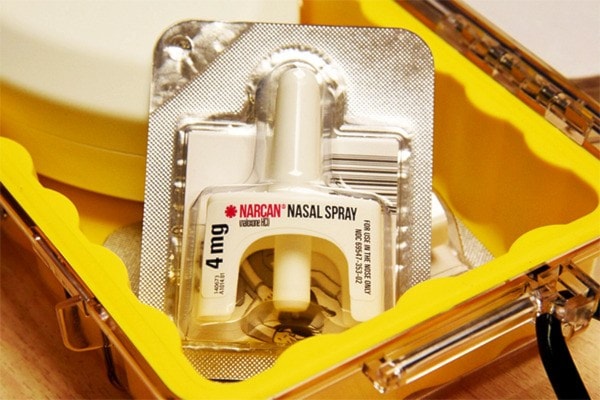As the fentanyl crisis rages on throughout the Lower Mainland, the Delta Police Department is equipping its officers with naloxone kits to help keep them – and the public – safe.
The DPD expected to have all at-risk staff to be trained and personally issued, or have access to, Narcan (a brand of naloxone) nasal spray kits by Dec. 14. This includes not only front-line patrol officers but others throughout the organization who may be exposed to fentanyl while carrying out their duty, such as drug section members, exhibits management staff and most other sections within the department.
Delta’s police board gave preliminary approval to outfit officers with naloxone on Sept. 15 following the first of two community forums on fentanyl held to address a string of overdoses in the municipality. Roll-out of the DPD’s naloxone protocol began in mid-November at a cost of $30,000 for the kits and training.
“We are very fortunate in that our police board is very responsive to emerging issues, such as the fentanyl crisis,” said Delta Police Chief Neil Dubord. “We have been in a position to mobilize a strategy that would equip our officers and staff with naloxone to be in a position to offer a potentially lifesaving measure in overdose cases.”
Fentanyl is a synthetic opioid 100 times more powerful than morphine. It’s used legitimately in hospitals as a painkiller and prescribed in the form of prescription patches for long-term pain management.
A lethal dose of pure fentanyl is estimated to be about two milligrams for a typical adult, the equivalent of a couple of grains of salt, so the risk to users is extremely high.
To make matters worse, fentanyl cannot be detected by look, smell or taste, and dealers seldom tell users they are selling fentanyl-laced product.
Because of its potency and relatively low cost, fentanyl has in recent years been used increasingly by drug dealers to cut their product and maximize their profits. The small amount needed also makes it easier to smuggle into the country.
“The problem with fentanyl is it doesn’t take a lot of fentanyl to produce a lot of street-level drugs. So, for instance, if you think of [how] two milligrams or two grains of salt is enough to kill you, think of [how far] a pound of fentanyl could go,” said Delta Police Sgt. Dave Vaughan-Smith at September’s fentanyl forum.
“Dealers, it’s all about making money for these guys and that’s why fentanyl is so lucrative for them; a small amount goes a really long way and produces a lot of drugs. So fentanyl can be easily smuggled in just because of its size and the way it’s packaged and created.”
Fentanyl is used widely as a cutting agent in heroin and counterfeit oxycodone pills, but has been increasingly found in street level cocaine and other drugs.
A total of 128 total people died from illicit drug overdose deaths in November - the highest monthly death total in 2016.
The newest stats bring the year-to-date death toll to 755 people, compared to 443 for the same time period in 2015.
Fentanyl has been detected in 374 deaths this year, or about 60 per cent. This is triple the amount from same time period last year.
Those numbers are expected to go up as provincial chief coroner Lisa Lapointe said December so far is looking like a "bad month."
– With files from Ashley Wadhwani/Black Press
